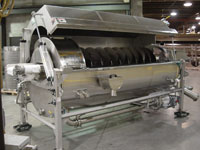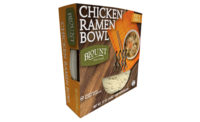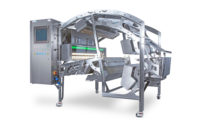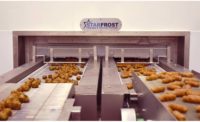
Preparing the perfect consistency of rice when cooked in small batches on the home stove is usually no problem for household chefs, but processing 10,000 pounds of rice per hour -- while striving to maintain consistent quality -- can present a considerable technical challenge for food processors.
Conventional high-volume processes used for the cooking and cooling of rice after parboiling frequently result in variations in the appearance and texture of the rice -- an undesirable physical breakdown of the rice grains and an adulteration of its flavor. There has, for some time now, been a need for a more effective method that preserves the integrity of the parboiled rice throughout this secondary preparation process. The goal is a process capable of producing a higher level of consistency comparable to freshly prepared rice, for use in high-volume processing of ready-to-eat refrigerated, frozen and canned meals.
Rice in prepared foods
Although more than 100 varieties of rice are commercially produced in the United States, three predominant types prevail: Indica long grain rice (known as Southern Long Grain), Indica medium grain rice (known as Southern Medium Grain), and short- and medium-grain Japonica varieties (known as Calrose).
Long grain rice represents the majority of total rice sold in the U.S., and is preferred when separateness of the grains is desired. Sixteen percent of all rice produced in the U.S. is used in processed refrigerated, frozen and canned foods, and Southern Long Grain is the predominant rice used for these food products.
For prepared foods, parboiled long grain rice is most often used because of its ease of preparation and durability. Parboiling is an optional processing step, prior to rice milling.
In parboiling, the rice is subjected to a water-soak and steam-pressure treatment process while still a brown rice, which gelatinizes the starch within the rice kernel. Gelatinization is a disruption of the crystalline structure of the rice starch, causing the starch granules to melt together. Crystalline structure does not allow water entry, so heat is applied to cause the crystalline regions to become diffused, allowing the penetration of water.
Parboiling increases randomness in the general starch structure and decreases the number and size of crystalline regions. The process causes nutrients from the outer bran to precipitate into the grain itself, preventing the loss of valuable nutrients during subsequent milling and improving the shelf life of the rice. It also mends cracks in the rice, acting as a gluing agent.
After parboiling and drying, the grain structure becomes compact, the content of vitamins and mineral salts is enhanced, and the moisture content is reduced to about 13 percent. The rice then goes through the normal milling process which reduces it to about 68 percent of the harvested paddy rice by weight. The result is firmer, more separate rice grains that are more stable, less brittle and less susceptible to overcooking than regular-milled white rice, which simply has the bran completely milled off.
Parboiled-milled rice, regular-milled white rice and brown rice can be cooked and dried before packaging to provide prepared-food products that require very short consumer preparation times – from as little as 90 seconds to 15 minutes.
With such instant, quick-cooking and boil-in-bag products, the rice is blanched in hot water, steamed and rinsed, then placed in dehydration ovens until the moisture content reaches approximately 12 percent. The basic principle involves increasing moisture of the rice by using steam or water to form cracks or holes in the kernels. These fast-cooking properties come from the fact that when the rice is re-cooked, water can penetrate into the cracked grain much more quickly.
Individually quick frozen (IQF) rice goes one step further. The cooked rice grains are then individually frozen before packaging to provide a free-flowing ingredient for use in frozen and prepared food products.
High-volume rice cooking / cooling
When long-grain rice is used in prepared refrigerated, frozen or canned foods, a number of factors come into play influencing the quality of the rice as it is going through the cooking and subsequent cooling processes. As mentioned, the majority of the rice will already have been parboiled and received by the food processor as such, or as regular-milled white rice and brown rice for instant-rice products.
During cooking or blanching, the rice is introduced into the cooker as small individual kernels. As these kernels are cooked or steamed for long periods of time, at between 195F and 205F, if the cooking is not stopped appropriately the kernels will eventually split open and fall apart. Starch is then freed or released from the kernels and the rice becomes sticky or pasty and may mass into undesirable clumps.
The cooking process, and the potential leaching out of the freed starch, will continue until the rice stops cooking, which means the temperature of the rice must be below 100F.
Minimizing or eliminating leaching, and maintaining firm and compact individual grains of rice throughout the entire cooking cycle would be considered a critical condition for proper texture and appearance in a packaged, ready-to-eat meal or other prepared food product. The cooked quality of the rice should be assayed against rice texture, color, amount of free starch or stickiness of the cooked rice, and kernel integrity.
Cooks talk about rice being al dente, so when they bite into it the rice is still firm in the middle, and ready to eat. On a stovetop basis, that works. But with a high-volume throughput of 10,000 pounds of rice per hour, the process becomes somewhat more complex. In fact, until recently, no rice cookers capable of processing 10,000 pounds per hour (or more) have mastered the technique of consistently produced firm and relatively un-leached rice, with high kernel integrity.
There is still volume batch processing of rice. Cooked in kettles, a specific level of rice and water is added. At the end of the cooking process the excess water is drained, and cold water is added and again stirred. That water is then drained, and more cold water is added and stirred.
No matter how much automation might be employed, this is largely a manual and labor-intensive method, prone to the discrepancies of human intervention in monitoring process times and temperatures. The stirring itself, which is largely a manual process is not without producing some damage to the rice kernels. Whatever the high-volume quantities that are being processed, the batch method has not been able to achieve consistently firm rice with a high-level of kernel integrity.
A more conventional system for high-volume cooking of rice is the continuous line using steam cooking. The rice is carried on a belt conveyor through a steaming sequence. The rice is heated by steam, which begins the cooking process. Water is then sprinkled onto the grain while it is agitated, causing the grains to absorb it. The rice is then again heated by steam, continuing the cooking process.
Some systems utilize conveyor belts running at different levels, independent of each other, to achieve higher volume throughput. To stop the cooking process, the rice is then moved along on a conveyor while chilled air is force-blown on the rice stream. A version of this cooling process uses a water spray within an open cylinder which covers the rice with a cold water spray to reduce its temperature after cooking.
These continuous units have the benefit of being controlled with PLCs (programmable logic controllers), which coordinate the belt movements with sensors that determine the temperature of the rice at various positions throughout the process.
Despite the improvement in automation over the batch method, conveyor cooker/cooler systems are only as good as their ability to stop the cooking process.
Most chilling equipment systems are a compromise with system inefficiencies and operational time and temperature unpredictability, primarily with inadequate and non-uniform airflow, thereby not stopping the cooking process adequately. These conveyor heating and cooling systems require extensive supervision, and the designs make cleaning and maintenance difficult and therefore time-consuming. Similar to the batch method, when handling high-volume throughput, conveyor cooker/cooler systems have not demonstrated that they can consistently produce firm rice with a high-level of kernel integrity.
Similarly, semi-continuous processing rotary drum cooker/coolers have been employed for some time, but without the ability to handle high-volume throughput with an acceptable level of product consistency.
Continuous processing for cooking and cooling rice, and the integration of PLC controls for automated processing has, however, opened the door to modern recipe management enabling rice producers to meet the changing demands of consumers.
Food processors are adapting to producing a wide variety of flavored rice, and rice meal complements such as including chicken, carrots, mushrooms, broccoli and peas, and recent developments in rice cooking/cooling technology have provided the flexibility to handle these changes while maintaining, for the first time, consistent rice quality.
One rice high-volume, cooking/cooling system, designed by Lyco Manufacturing, is representative of the latest developments in the technology, having a truly continuous process for cooking and cooling rice with virtually 100-percent consistency.
The system utilizes two completely enclosed rotary drum cylinders, one for cooking and one for cooling (ranging from 36” to 72” diameter, and 4’ to 32’ length), directly following in sequence. The drums have internal augers – a perforated skin sheet is wrapped around the drums and fixed to the auger’s flights. These flights gently move the rice through the cooker and cooler system while submerged in water. The rice is carefully agitated as it advances through the cylinders.
Once through the cooker machine, having reached the programmed temperature/time – in a first-in/first-out sequence – the rice is then gently deposited into the following cooling drum, and chilled to its programmed recipe temperature/time factor. Then the rice is released out of the machine for downstream combining with meat, vegetables, spices or other ingredients.
The system can process much more than 10,000 pounds of rice per hour, with damage to the delicate rice grains less than a fraction of one percent. The auger system gently mixes the rice so that all kernels are evenly heated. Rice is very fragile after cooking, the subsequent cooling process with the gentle auger mixing handles the kernels very carefully, even when the rice needs to be chilled longer to bring the temperature down to 40F for use in frozen meals.
A key component of this cooker/cooler technology is the first-in, first-out sequence of rice movement, which ensures that the rice grains get processed, each at the same time and temperature. This inhibits the rice from coming out non-uniform – some hard and some mushy. Additionally, because the system is fully enclosed and designed to 1/16th inch tolerance in the drum screens, there is no rice migration or product loss because of the small nature of the grain.
It also has the flexibility of running multiple products throughout the production day at different temperatures and at different retention times – a unique feature that this new-generation of equipment provides. For example, the equipment has the versatility to cook rice of different varieties (such as basmati, jasmine, brown, or wild rice), vegetables and pasta in the same system without needing to change-out processing screens. A version of the system is also available for steaming rice and vegetables.
New developments in food industry lean-manufacturing with rice rotary drum cooker/coolers have significantly minimized the cleaning changeover time on shorter runs to as low as 15 minutes, and on a totally automated mode without the need for manual labor. This can accommodate as many as two product changeovers per hour, or 16 changeovers per shift, if desired, allowing for maximum flexibility and efficiency. Clean-up times can be reduced as much as 75 percent compared to other rotary drum cookers.
Lean manufacturing in rice processing means a reduction in waste, it incorporates shorter runs, faster changeovers and smaller inventories. And that includes flexible equipment. The problem with short-runs lies in the down-time consumed to make the changeover for the next run. This means cleaning the equipment for each change and injecting inefficiencies of time delay into the processing line.
A lean manufacturing rice processing rotary drum system developed by Lyco, called Clean-Flow®, provides not only quick-cleaning for changeovers, but adds a water injection feature for added agitation to keep the rice in uniform suspension while moving through the process, even further reducing the possibility for grain damage.
Dedicated production lines will continue to have their place in rice processing. But, the need for specialized, flexible runs, with the ability to rapidly change from one product to another is an inevitable evolution in progress.
Full-absorption rice processing
High-volume, continuous, full-absorption rice cooking/cooling systems that use just the right ratio of rice to water are currently under research. The main benefit for going to a system that uses less water is to reduce the amount of free water remaining, and reduce water consumption.
Another plus with a full-absorption system is that processors can prepare flavored rice with liquid and particulate ingredients without dilution. For such a system to be commercially viable it would need to be able to process high-volume runs, such as 10,000 pounds per hour and greater. It should also have the capacity for relatively rapid changeovers, to accommodate the potential need for processing variations in rice batches. Several systems for short runs are commercially available, but have limitations that influence process throughput, rice quality and rapid changeovers, making them comparatively inefficient for high-volume rice processing. -- Lyco Manufacturing
(920) 623-4152 / www.lycomfg.com.


